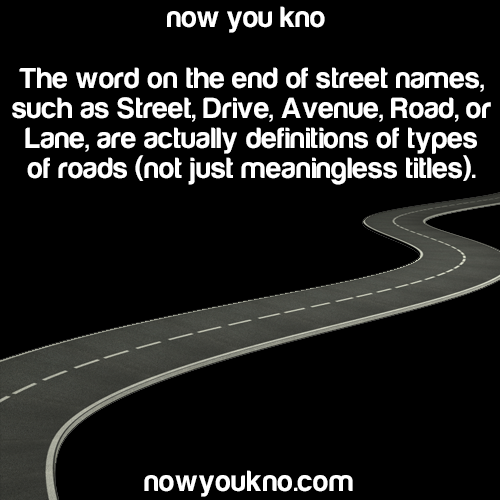#semantics of the road
Source for more facts follow NowYouKno
- A road has no special qualifiers. It connects point a to point b.
- A street connects buildings together, usually in a city, usually east to west, opposite of avenue.
- An avenue runs north south. Avenues and streets may be used interchangeably for directions, usually has median
- A boulevard is a street with trees down the middle or on both sides
- A lane is a narrow street usually lacking a median.
A drive is a private, winding road
A way is a small out of the way road
a court usually ends in a cul de sac or similar little loop
a plaza or square is usually a wide open space, but in modern definitons, one of the above probably fits better for a plaza as a road.
a terrace is a raised flat area around a building. When used for a road it probably better fits one of the above.
uk, a close is similar to a court, a short road serving a few houses, may have cul de sac
run is usually located near a stream or other small body of water
place is similar to a court, or close, usually a short skinny dead end road, with or without cul de sac, sometimes p shaped
bay is a small road where both ends link to the same connecting road
crescent is a windy s like shape, or just a crescent shape, for the record, above definition of bay was also given to me for crescent
a trail is usually in or near a wooded area
mews is an old british way of saying row of stables, more modernly seperate houses surrounding a courtyard
a highway is a major public road, usually connecting multiple cities
a motorway is similar to a highway, with the term more common in New Zealand, the UK, and Austrailia, no stopping, no pedestrian or animal traffic allowed
an interstate is a highway system connecting usually connecting multiple states, although some exist with no connections
a turnpike is part of a highway, and usully has a toll, often located close to a city or commercial are
a freeway is part of a highway with 2 or more lanes on each side, no tolls, sometimes termedexpressway, no intersections or cross streets.
a parkway is a major public road, usually decorated, sometimes part of a highway, has traffic lights.
a causeway combines roads and bridges, usually to cross a body of water
circuit and speedway are used interchangeably, usually refers to a racing course, practically probably something above.
as the name implies, garden is usually a well decorated small road, but probably better fits an above
a view is usually on a raised area of land, a hill or something similar.
byway is a minor road, usually a bit out of the way and not following main roads.
a cove is a narrow road, can be sheltered, usually near a larger body of water or mountains
a row is a street with a continuous line of close together houses on one or both sides, usually serving a specific function like a frat
a beltway is a highway surrounding an urban area
quay is a concrete platform running along water
crossing is where two roads meet
alley a narrow path or road between buildings, sometimes connects streets, not always driveable
point usually dead ends at a hill
pike usually a toll road
esplanade long open, level area, usually a walking path near the ocean
square open area where multiple streets meet, guess how its usually shaped.
landing usually near a dock or port, historically where boats drop goods.
walk historically a walking path or sidewalk, probably became a road later in its history
grove thickly sheltered by trees
copse a small grove
driveway almost always private, short, leading to a single residence or a few related ones
laneway uncommon, usually down a country road, itself a public road leading to multiple private driveways.
trace beaten path
circle usually circles around an area, but sometimes is like a “square”, an open place intersected by multiple roads.
channel usually near a water channel, the water itself connecting two larger bodies of water,
grange historically would have been a farmhouse or collection of houses on a farm, the road probably runs through what used to be a farm
park originally meaning an enclosed space, came to refer to an enclosed area of nature in a city, usually a well decorated road.
mill probably near an old flour mill or other mill.
spur similar to a byway, a smaller road branching off from a major road.
bypass passes around a populated area to divert traffic
roundabout or traffic circle circle around a traffic island with multiple connecting routes, a roundabout is usually smaller, with less room for crossing and passing, and safer
wynd a narrow lane between houses, similar to an alley, more common in UK
drive shortened form of driveway, not a driveway itself, usually in a neighborhood, connects several houses
parade wider than average road historically used as a parade ground.
terrace more common in uk, a row of houses.
chase on land historically used as private hunting grounds.
branch divides a road or area into multiple subdivisions.
With the “alley” in the UK we have more lpcal terms as well such as “ginnel”, “snicket” and “vennel” (the first two more Yorkshire and Lancashire, the third specifically Durham).
Another word for “close” is “fold”. That’s the word used in the name of the street I live on.
Also, in York, all roads are just “-gates” :)
Post link

